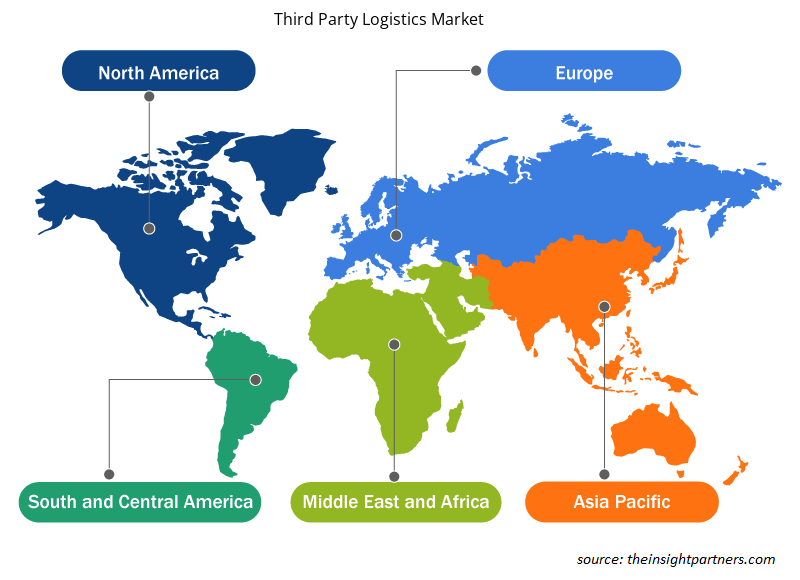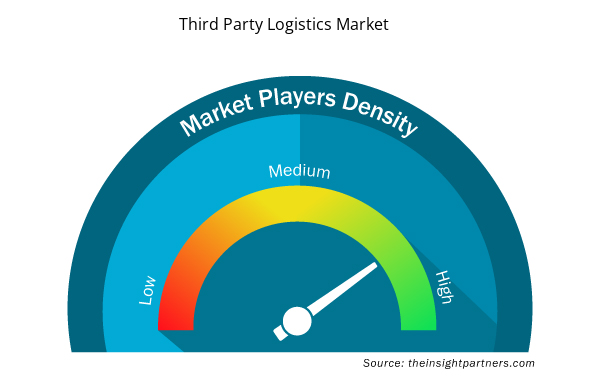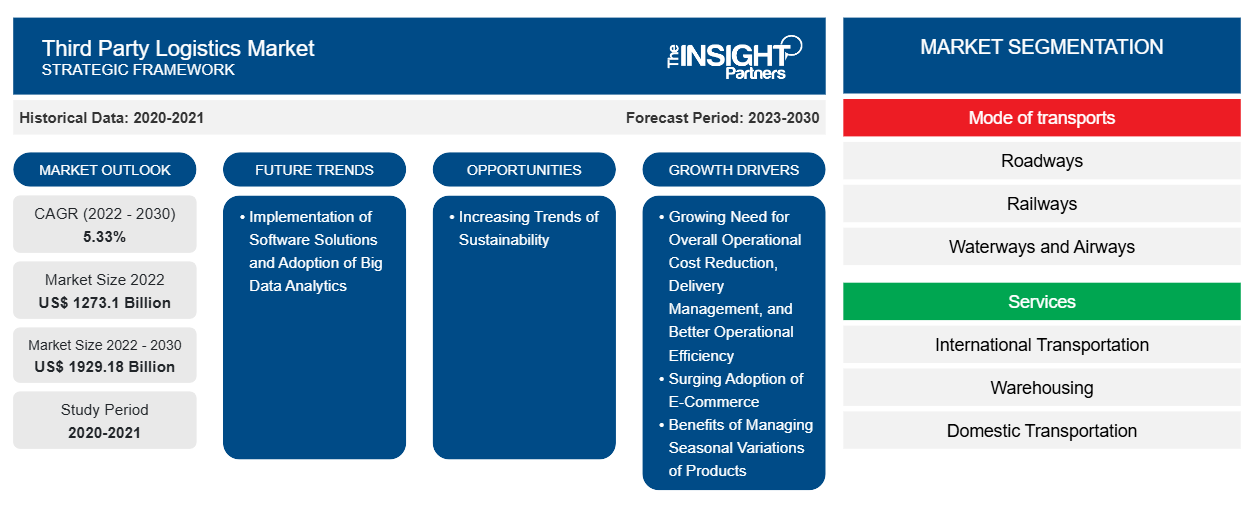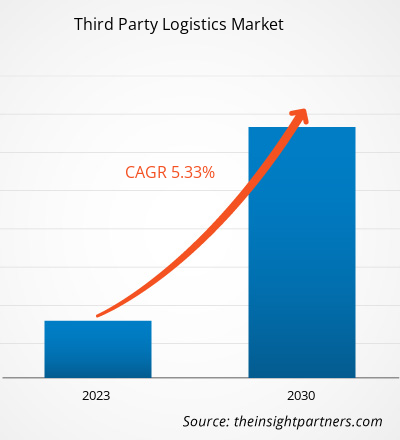El mercado de logística de terceros se valoró en US$ 1273,1 mil millones en 2022 y se proyecta que alcance los US$ 1929,18 mil millones para 2030; se espera que registre una CAGR del 5,33% durante 2022-2030.
Es probable que la creciente proliferación del comercio electrónico siga siendo una tendencia clave en el mercado.
Análisis del mercado de logística de terceros
El auge del comercio electrónico y el deseo de entregas en el mismo día o al día siguiente impulsan la demanda de servicios de entrega de última milla. Por ejemplo, el servicio Prime de Amazon ha establecido nuevos estándares de entrega rápida, lo que ha impulsado a los 3PL a adaptar sus servicios para cumplir con estas expectativas. La creciente conciencia de los problemas ambientales y la sostenibilidad ha llevado a una mayor demanda de soluciones logísticas ecológicas. Los proveedores 3PL están adoptando vehículos eléctricos, optimizando las rutas para reducir las emisiones e implementando prácticas de embalaje sostenibles para alinearse con las expectativas de los consumidores y las regulaciones.
Descripción general del mercado de logística de terceros
El transporte de los productos manufacturados desde las fábricas hasta los almacenes es la primera etapa del proceso 3PL general. La empresa 3PL almacena el producto una vez que llega al almacén o centro de distribución. Los productos se almacenan de acuerdo con su SKU, y cada SKU tiene su propio lugar de almacenamiento asignado. Los artículos que ingresan al almacén normalmente se ingresan en el sistema de seguimiento del proveedor en este punto. La integración de software ayuda a lograr procesos eficientes y efectivos.
Personalice este informe según sus necesidades
Obtendrá personalización en cualquier informe, sin cargo, incluidas partes de este informe o análisis a nivel de país, paquete de datos de Excel, así como también grandes ofertas y descuentos para empresas emergentes y universidades.
- Obtenga las principales tendencias clave del mercado de este informe.Esta muestra GRATUITA incluirá análisis de datos, desde tendencias del mercado hasta estimaciones y pronósticos.
Factores impulsores y oportunidades del mercado de logística de terceros
Beneficios de gestionar las variaciones estacionales de los productos para favorecer el mercado
Las empresas de logística de terceros han ampliado sus redes de recursos para ayudar a las empresas de primera línea a expandirse de manera eficiente y rentable. Además, las empresas de logística de terceros pueden ofrecer recursos y elasticidad suficientes en los servicios para inventarios estacionales o lanzamientos de nuevos productos. Muchos establecimientos experimentan variaciones estacionales en las inclinaciones de los clientes, y resulta clave gestionar dichas oscilaciones para mantener la eficacia y satisfacer la demanda.
Aplicación de soluciones de software y adopción de análisis de big data
También se espera que la adopción de dispositivos habilitados con RFID almacene datos para facilitar el transporte, lo que también simplificará el seguimiento y la identificación de los productos. El software relacionado con los sistemas de gestión del transporte reducirá la ineficiencia y los costos. Además, el uso de software de reconocimiento de voz en las comunicaciones del sistema de gestión de almacenes ayudará con la gestión de pedidos y los registros de inventario, al tiempo que reduce las necesidades de capacitación de los empleados. Junto con esto, la aceptación de la tecnología basada en la nube en las organizaciones de logística de terceros responderá a las demandas al reconocer la necesidad de acceso de los clientes, lo que les permitirá abordar mejor las tendencias estacionales.
Análisis de segmentación del informe de mercado de logística de terceros
Los segmentos clave que contribuyeron a la derivación del análisis del mercado de logística de terceros son el modo de transporte, los servicios y los usuarios finales.
- Según el modo de transporte, el mercado de logística de terceros se divide en carreteras, ferrocarriles, vías navegables y vías aéreas. El segmento de carreteras tuvo una mayor participación de mercado en 2023.
- Según los servicios, el mercado de logística de terceros se divide en transporte internacional, almacenamiento, transporte nacional, gestión de inventarios y otros. El segmento de transporte nacional tuvo una mayor participación de mercado en 2023.
- Según los usuarios finales, el mercado de logística de terceros se divide en automoción, atención médica, venta minorista, bienes de consumo yOtros. El segmento Otros tuvo una mayor participación de mercado en 2023.
Análisis de la cuota de mercado de logística de terceros por geografía
El alcance geográfico del informe del mercado de logística de terceros se divide principalmente en cinco regiones: América del Norte, Asia Pacífico, Europa, Medio Oriente y África, y América del Sur y Central.
El alcance del informe del mercado de logística de terceros abarca América del Norte (EE. UU., Canadá y México), Europa (Rusia, Reino Unido, Francia, Alemania, Italia y el resto de Europa), Asia Pacífico (Corea del Sur, India, Australia, Japón, China y el resto de Asia Pacífico), Oriente Medio y África (Arabia Saudita, Sudáfrica, Emiratos Árabes Unidos y el resto de Oriente Medio y África) y América del Sur y Central (Argentina, Brasil y el resto de América del Sur y Central). En términos de ingresos, Asia Pacífico dominó la participación de mercado de logística de terceros en 2023. Europa es el segundo mayor contribuyente al mercado global de logística de terceros, seguida de América del Norte.
Perspectivas regionales del mercado de logística de terceros
Los analistas de Insight Partners explicaron en detalle las tendencias y los factores regionales que influyen en el mercado de logística de terceros durante el período de pronóstico. Esta sección también analiza los segmentos y la geografía del mercado de logística de terceros en América del Norte, Europa, Asia Pacífico, Oriente Medio y África, y América del Sur y Central.

- Obtenga datos regionales específicos para el mercado de logística de terceros
Alcance del informe de mercado de logística de terceros
| Atributo del informe | Detalles |
|---|---|
| Tamaño del mercado en 2022 | US$ 1273,1 mil millones |
| Tamaño del mercado en 2030 | US$ 1929,18 mil millones |
| CAGR global (2022-2030) | 5,33% |
| Datos históricos | 2020-2021 |
| Período de pronóstico | 2023-2030 |
| Segmentos cubiertos | Por modo de transporte
|
| Regiones y países cubiertos | América del norte
|
| Líderes del mercado y perfiles de empresas clave |
|
Densidad de actores del mercado: comprensión de su impacto en la dinámica empresarial
El mercado de logística de terceros está creciendo rápidamente, impulsado por la creciente demanda de los usuarios finales debido a factores como la evolución de las preferencias de los consumidores, los avances tecnológicos y una mayor conciencia de los beneficios del producto. A medida que aumenta la demanda, las empresas amplían sus ofertas, innovan para satisfacer las necesidades de los consumidores y aprovechan las tendencias emergentes, lo que impulsa aún más el crecimiento del mercado.
La densidad de actores del mercado se refiere a la distribución de las empresas o firmas que operan dentro de un mercado o industria en particular. Indica cuántos competidores (actores del mercado) están presentes en un espacio de mercado determinado en relación con su tamaño o valor total de mercado.
Las principales empresas que operan en el mercado de logística de terceros son:
- CEVA Logística
- FedEx
- Expedidores
- Logística SF
- Logística Maersk
Descargo de responsabilidad : Las empresas enumeradas anteriormente no están clasificadas en ningún orden particular.

- Obtenga una descripción general de los principales actores clave del mercado de logística de terceros
Noticias y desarrollos recientes del mercado de logística de terceros
El mercado de logística de terceros se evalúa mediante la recopilación de datos cualitativos y cuantitativos a partir de una investigación primaria y secundaria, que incluye publicaciones corporativas importantes, datos de asociaciones y bases de datos. A continuación, se enumeran algunos de los avances en el mercado de logística de terceros:
- DB Schenker, uno de los principales proveedores de servicios logísticos del mundo, y USA Truck, un proveedor líder de soluciones de capacidad, anunciaron un acuerdo en virtud del cual DB Schenker adquirirá todas las acciones en circulación de USA Truck por 31,72 dólares por acción en efectivo. La transacción le cuesta a USA Truck aproximadamente 435 millones de dólares, incluidos el efectivo y la deuda asumidos. (Fuente: DB Schenker, comunicado de prensa, julio de 2022)
- Deutsche Post DHL Group, la empresa de logística líder a nivel mundial, anunció hoy que cambiará el nombre de la empresa a "DHL Group" a partir del 1 de julio de 2023. El nuevo nombre refleja la transformación que ha experimentado el Grupo en los últimos años y rinde homenaje al enfoque en sus actividades logísticas nacionales e internacionales como motor del crecimiento futuro. (Fuente: DHL Group, comunicado de prensa, julio de 2023)
Informe de mercado de logística de terceros: cobertura y resultados
El informe “Tamaño y pronóstico del mercado de logística de terceros (2020-2030)” proporciona un análisis detallado del mercado que cubre las siguientes áreas:
- Tamaño del mercado de logística de terceros y pronóstico a nivel global, regional y nacional para todos los segmentos clave del mercado cubiertos bajo el alcance
- Tendencias del mercado de logística de terceros, así como dinámicas del mercado, como impulsores, restricciones y oportunidades clave
- Análisis PEST y FODA detallados
- Análisis del mercado de logística de terceros que cubre las tendencias clave del mercado, el marco global y regional, los principales actores, las regulaciones y los desarrollos recientes del mercado.
- Análisis del panorama de la industria y de la competencia que abarca la concentración del mercado, el análisis de mapas de calor, los actores destacados y los desarrollos recientes para el mercado de logística de terceros
- Perfiles detallados de empresas
- Análisis histórico (2 años), año base, pronóstico (7 años) con CAGR
- Análisis PEST y FODA
- Tamaño del mercado Valor/volumen: global, regional, nacional
- Industria y panorama competitivo
- Conjunto de datos de Excel



Report Coverage
Revenue forecast, Company Analysis, Industry landscape, Growth factors, and Trends

Segment Covered
This text is related
to segments covered.

Regional Scope
North America, Europe, Asia Pacific, Middle East & Africa, South & Central America

Country Scope
This text is related
to country scope.
Preguntas frecuentes
Asia Pacific dominated the third party logistics market in 2022.
The investment in research & development by manufacturers is the future trend of the third party logistics market.
US$ 1929.18 billion estimated value of the third party logistics market by 2030.
6.6% is the expected CAGR of the third party logistics market.
DHL Group, Kuehne + Nagel International AG, DB Schenker, C.H. Robinson Worldwide Inc., DSV AS, Sinotrans Ltd., Giodis SA, United Parcel Service Inc., XPO Inc., Torello Transpoti Srl are some of the leading players in the market.
Trends and growth analysis reports related to Automotive and Transportation : READ MORE..
The List of Additional Companies - Third party logistics market
- CEVA Logistics
- FedEx
- Expeditors
- SF Logistics
- Maersk Logistics
- Kintetsu World Express
- Yusen Logistics
- Toll Group
- Hellmann Worldwide Logistics
- Penske Logistics
The Insight Partners performs research in 4 major stages: Data Collection & Secondary Research, Primary Research, Data Analysis and Data Triangulation & Final Review.
- Data Collection and Secondary Research:
As a market research and consulting firm operating from a decade, we have published and advised several client across the globe. First step for any study will start with an assessment of currently available data and insights from existing reports. Further, historical and current market information is collected from Investor Presentations, Annual Reports, SEC Filings, etc., and other information related to company’s performance and market positioning are gathered from Paid Databases (Factiva, Hoovers, and Reuters) and various other publications available in public domain.
Several associations trade associates, technical forums, institutes, societies and organization are accessed to gain technical as well as market related insights through their publications such as research papers, blogs and press releases related to the studies are referred to get cues about the market. Further, white papers, journals, magazines, and other news articles published in last 3 years are scrutinized and analyzed to understand the current market trends.
- Primary Research:
The primarily interview analysis comprise of data obtained from industry participants interview and answers to survey questions gathered by in-house primary team.
For primary research, interviews are conducted with industry experts/CEOs/Marketing Managers/VPs/Subject Matter Experts from both demand and supply side to get a 360-degree view of the market. The primary team conducts several interviews based on the complexity of the markets to understand the various market trends and dynamics which makes research more credible and precise.
A typical research interview fulfils the following functions:
- Provides first-hand information on the market size, market trends, growth trends, competitive landscape, and outlook
- Validates and strengthens in-house secondary research findings
- Develops the analysis team’s expertise and market understanding
Primary research involves email interactions and telephone interviews for each market, category, segment, and sub-segment across geographies. The participants who typically take part in such a process include, but are not limited to:
- Industry participants: VPs, business development managers, market intelligence managers and national sales managers
- Outside experts: Valuation experts, research analysts and key opinion leaders specializing in the electronics and semiconductor industry.
Below is the breakup of our primary respondents by company, designation, and region:

Once we receive the confirmation from primary research sources or primary respondents, we finalize the base year market estimation and forecast the data as per the macroeconomic and microeconomic factors assessed during data collection.
- Data Analysis:
Once data is validated through both secondary as well as primary respondents, we finalize the market estimations by hypothesis formulation and factor analysis at regional and country level.
- Macro-Economic Factor Analysis:
We analyse macroeconomic indicators such the gross domestic product (GDP), increase in the demand for goods and services across industries, technological advancement, regional economic growth, governmental policies, the influence of COVID-19, PEST analysis, and other aspects. This analysis aids in setting benchmarks for various nations/regions and approximating market splits. Additionally, the general trend of the aforementioned components aid in determining the market's development possibilities.
- Country Level Data:
Various factors that are especially aligned to the country are taken into account to determine the market size for a certain area and country, including the presence of vendors, such as headquarters and offices, the country's GDP, demand patterns, and industry growth. To comprehend the market dynamics for the nation, a number of growth variables, inhibitors, application areas, and current market trends are researched. The aforementioned elements aid in determining the country's overall market's growth potential.
- Company Profile:
The “Table of Contents” is formulated by listing and analyzing more than 25 - 30 companies operating in the market ecosystem across geographies. However, we profile only 10 companies as a standard practice in our syndicate reports. These 10 companies comprise leading, emerging, and regional players. Nonetheless, our analysis is not restricted to the 10 listed companies, we also analyze other companies present in the market to develop a holistic view and understand the prevailing trends. The “Company Profiles” section in the report covers key facts, business description, products & services, financial information, SWOT analysis, and key developments. The financial information presented is extracted from the annual reports and official documents of the publicly listed companies. Upon collecting the information for the sections of respective companies, we verify them via various primary sources and then compile the data in respective company profiles. The company level information helps us in deriving the base number as well as in forecasting the market size.
- Developing Base Number:
Aggregation of sales statistics (2020-2022) and macro-economic factor, and other secondary and primary research insights are utilized to arrive at base number and related market shares for 2022. The data gaps are identified in this step and relevant market data is analyzed, collected from paid primary interviews or databases. On finalizing the base year market size, forecasts are developed on the basis of macro-economic, industry and market growth factors and company level analysis.
- Data Triangulation and Final Review:
The market findings and base year market size calculations are validated from supply as well as demand side. Demand side validations are based on macro-economic factor analysis and benchmarks for respective regions and countries. In case of supply side validations, revenues of major companies are estimated (in case not available) based on industry benchmark, approximate number of employees, product portfolio, and primary interviews revenues are gathered. Further revenue from target product/service segment is assessed to avoid overshooting of market statistics. In case of heavy deviations between supply and demand side values, all thes steps are repeated to achieve synchronization.
We follow an iterative model, wherein we share our research findings with Subject Matter Experts (SME’s) and Key Opinion Leaders (KOLs) until consensus view of the market is not formulated – this model negates any drastic deviation in the opinions of experts. Only validated and universally acceptable research findings are quoted in our reports.
We have important check points that we use to validate our research findings – which we call – data triangulation, where we validate the information, we generate from secondary sources with primary interviews and then we re-validate with our internal data bases and Subject matter experts. This comprehensive model enables us to deliver high quality, reliable data in shortest possible time.


 Obtenga una muestra gratuita de este informe
Obtenga una muestra gratuita de este informe